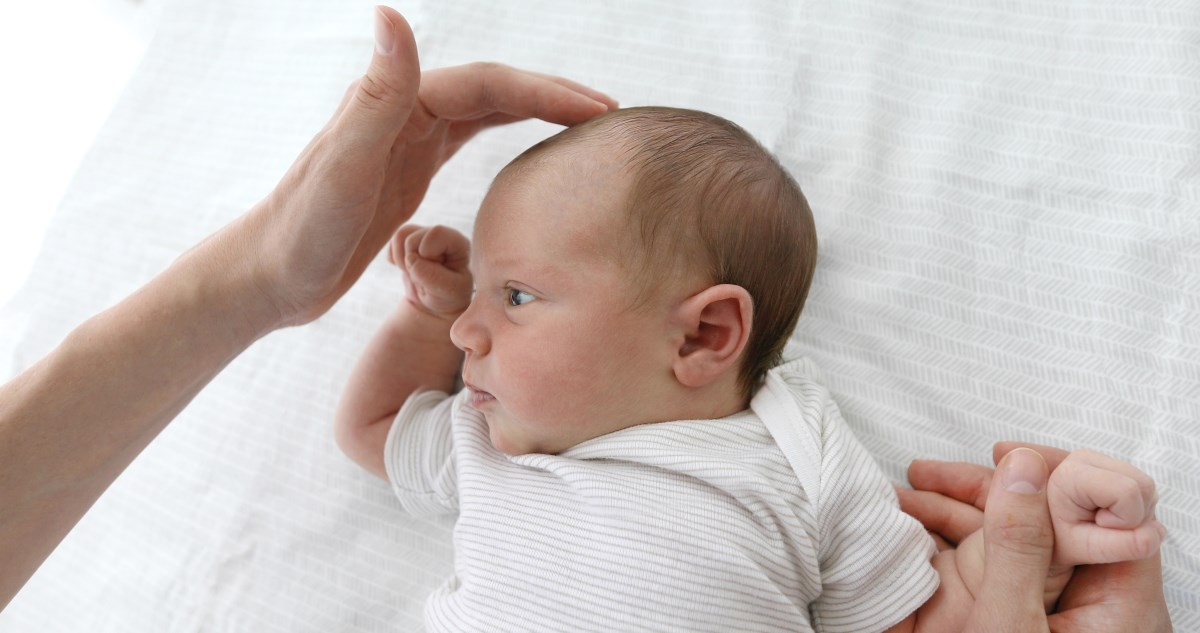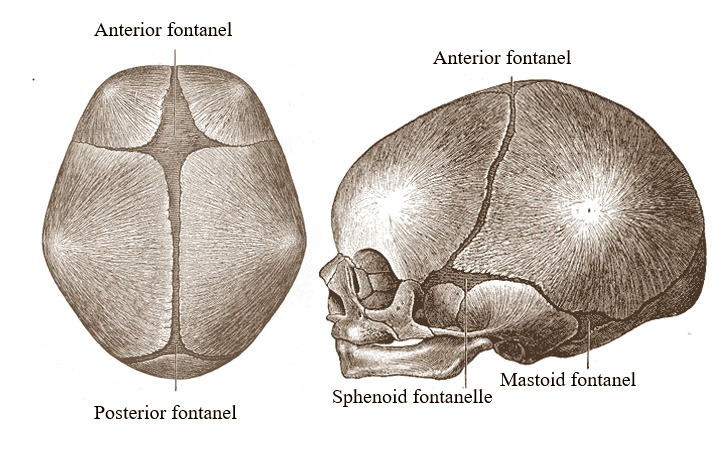Can You Hurt Your Baby by Pushing Too Hard on Your Belly
How easy is it to injure a baby's soft spot?
A infant'south fontanels may seem easy to injure, but in reality, they are non that vulnerable. Still, information technology is very mutual to worry that ane may have hurt a babe'southward fontanel if accidentally pushed or pressed on with too much forcefulness.
Learn all about babies' fontanels hither, including the warning signs that your baby's soft spots are injured or if there is something wrong with them.

Mom' Question:
Did I injure baby'southward fontanelle?! I accidentally pushed my baby'southward soft spot while trying to grab/correct his head when he pulled away suddenly. Accept I hurt information technology or him?
How like shooting fish in a barrel is it to hurt a baby's fontanel and his brain?
Fontanel Facts & The Take chances Hurting A Infant's Soft Spot (Fontanel)
What is a Infant's Fontanelle?
A infant'south soft spot or fontanel (also spelled fontanelle), is made of a tough, gristly membrane, formed where skull bones and sutures join. There are several fontanels in a babe'southward head. These fontanels permit for the brain and skull to grow during the start yr of life. The sutures, subsequently on, mineralize and solidify to bring together the skull bones together.

A newborn babe has 6 fontanels namely:
- Anterior – this is the most significant clinically, of all fontanels. This offers an insight as to the baby'south hydration status and encephalon well-existence. This fontanel closes between xiii to 24 months.
- Posterior – this fontanel closes within six to 8 weeks of birth.
- Mastoid (2) – these fontanels close betwixt 6 to 18 months of age.
- Sphenoid (2) – these fontanels close by the 6th month of age.
Characteristically, these fontanels are apartment, soft, however firm. A sunken anterior fontanel indicates dehydration, while jutting indicates an increase in intracranial pressure (too much fluid in the brain) that may be due to infection, anatomical abnormality, or hemorrhage.
The image below shows the gradual closure of the inductive and posterior fontanels.

Babies built-in through VBAC often have quite a funny head shape – egg-shaped head – which is due to these fontanels. Every bit moms, nosotros should all be happy that they exist!
This video provides a throrough guide to what the fontanelles are, why we take them and certain conditions that will touch on the fontanelles:
How Vulnerable are the Fontanelles?
A lot of parents, myself included the first time, are very afraid to fifty-fifty touch their babe'south fontanel – worried that they will hurt baby'south fontanelle. It is a very special area of a infant's body and even a target for folk myths as you can read nearly hither. But the soft spot is more like a helmet for the babe'due south brain than the reverse. And merely think of the pressure level on the spot during nascence; a baby's soft spot cannot be that vulnerable!
Certainly, accidents tin occur, and direct penetration through the soft spot would happen more hands than through the skull, which is very dangerous. But an unintentional push is non likely to be unsafe unless it was hard. Your child will manifest pain through crying or other abnormalities relating to the brain if he was truly injure, otherwise, I wouldn't recall besides much about information technology.
And then if it is only the case that yous happened to push your baby'due south soft spot a flake while taking intendance of your baby, it is very unlikely that he was injured.
If the push was very hard or if yous notice whatsoever changes in your baby'southward behavior (appears extra sleepy, lightheaded, or anything like that), do contact a dr. immediately.
Alarm Signs from Babe'due south Soft Spot
In add-on to straight penetration, a hard push, or autumn, there are other signs seen on the fontanels (particularly the inductive fontanel) that would requite y'all an insight into whether your baby is salubrious or not.
But offset, nosotros have to review the normal before we delve into the abnormal signs:
The fontanels are usually soft, notwithstanding business firm, with a slight depression when touched. In examining the anterior fontanel, the baby should be at-home. Crying babies may have jutting or total fontanels. The fontanel should be examined at a supine and upright position. It should reveal a soft opening on the caput, not tensed when touched. However, a slight pulsation volition be felt when you touch on it, which is normal.
1. A Swollen or Bulging Fontanelle
If the fontanel appears swollen or bulging and tensed when you lot affect information technology, call your physician immediately. This should exist accompanied past any of the signs and symptoms that will betoken a a traumatic caput injury.:
- Persistent vomiting
- Abnormally drowsy or altered mental state
- Fever
- Limp upper and lower limbs
- Neck rigidity
- Seizures
These signs could indicate increased intracranial pressure brought about by a lot of causes: infection (meningitis, encephalitis), hypoxic-ischemic brain injury, hemorrhage in the brain, brain lesion, or mass, or hydrocephalus. This warrants immediate medical care.
2. A sunken fontanel
A sunken fontanel tin can indicate dehydration. For babies with a history of diarrhea, depression to no fluid intake, or a chronic disease, the fontanels are sunken upon test.
This is unremarkably accompanied by dry out optics (no tears when crying), sunken eyeballs, poor pare turgor, and loss of appetite (no food or fluid intake). This is another reddish flag. Yous take to accept your infant to the emergency room ASAP.
3. Premature Closure of Fontanels or Minor Fontanels
Closure of fontanels as early as three months of historic period is within normal limits, however, nosotros should monitor the size of the head. Small heads and small fontanels are usually indicative of abnormal brain development. Consult your md if your child seems to exhibit this.
Other conditions cause premature closure of fontanels or small fontanels. These are the almost common conditions:
- Congenital infections
- Chromosomal defects
- Fetal booze syndrome
- Hypoxic-ischemic encephalopathy
- Structural brain defect
- Endocrine issues (hyperthyroidism or hyperparathyroidism)
The premature closure of fontanels yielding an abnormal caput shape is chosen craniosynostosis. Surgery might exist needed for normal brain evolution and growth.
It is not like shooting fish in a barrel as a parent to assess the fontanel. If you are at all worried, talk to a doctor and have your baby examined.
4. Delayed Fontanel Closure or Big Fontanels
Congenital hypothyroidism is the almost common cause for delayed closure of fontanels or large fontanels.
Achondroplasia, Down's syndrome, and increased intracranial pressure are also common causes of this condition.
Congenital hypothyroidism is detected during newborn screening. Direction includes levothyroxine, which the child may take for a lifetime.
How to Protect My Baby's Fontnels?
There is not a lot you need to do to protect your baby's fontanels apart from protecting your baby from falls or whatsoever head trauma. Brand your dwelling baby-proof by eastward.thousand. lowering your bed peak, barriers on the stairs, and other elevated parts of your home. As well never leave your baby alone on the bed or irresolute table, even when newborn.
You lot practice not have to worry nearly touching your baby's fontanells.
Decision – How Easy is information technology to Hurt Baby's Fontanelle?
Fontanels have a meaning part in childbirth. They are likewise indicators of your child'southward health status. Nonetheless, an adventitious push button to the fontanel without force or endeavour should not injure your baby.
Always monitor for other signs or symptoms like ceaseless crying, abnormal drowsiness, and vomiting, as these could help you assess if your kid is suffering from a traumatic head injury. Otherwise, your kid should exist healthy.
Warm wishes,
Paula
Read Next
- Fontanelle Myths
- The baby fell off the bed – concussion warning signs
- Accused of kid corruption – baby fell
Inquiry References
- Craniosynostosis
- Congenital hypothyroidism
- Anatomy, Head and Neck, Fontanelles
- The Abnormal Fontanel
Add your comments below.
metzlermrsoled1961.blogspot.com
Source: https://www.easybabylife.com/hurt-babys-fontanelle-by-accident.html
0 Response to "Can You Hurt Your Baby by Pushing Too Hard on Your Belly"
Post a Comment